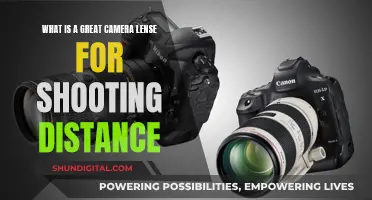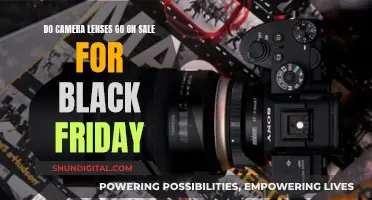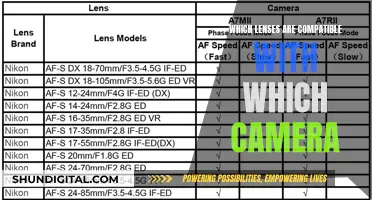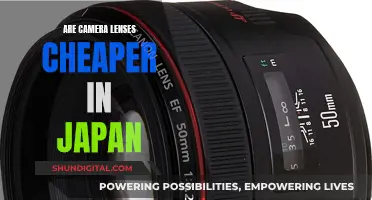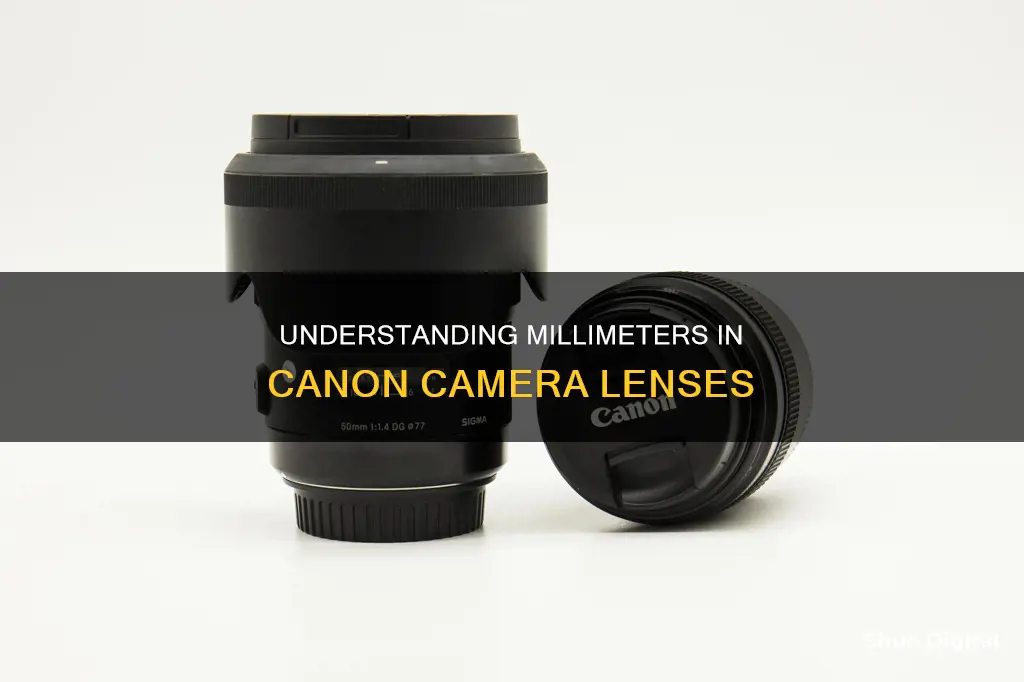
Millimetres, or mm for short, is the standard unit of measurement for the focal length of a lens. The 'mm' number printed on a lens is a measurement in millimetres of the focal length. This measurement is taken from the optical centre of the lens to the camera's sensor when focused on infinity. The focal length tells you the lens's field of view. The smaller the number, the wider the field of view. A lens with a 20mm focal length gives you a wide-angle view, while a 50mm lens is considered a standard angle, which is similar to the human eye. A 100mm focal length gives a tighter, more magnified view.
| Characteristics | Values |
|---|---|
| Unit of measurement | Millimeters (mm) |
| What it measures | Focal length of a lens |
| Focal length | The distance from the optical center of the lens to the camera's sensor |
| Focal length and field of view | The smaller the number of mm, the wider the field of view and vice versa |
| Focal length and magnification | The longer the focal length, the higher the magnification; the shorter the focal length, the lower the magnification |
| Focal length and type of lens | A short focal length is a wide-angle lens; a long focal length is a telephoto lens |
| Focal length and angle of view | A wide-angle lens has a wide angle of view; a telephoto lens has a narrow angle of view |
| Focal length and lens type | Zoom lenses have a variable focal length; prime lenses have a fixed focal length |

Focal length
Lenses with different focal lengths are designed for various shooting scenarios. A wide-angle lens, characterised by a shorter focal length, typically below 50mm, offers a broader field of view, making it ideal for landscape photography or when you want to capture more of a scene. On the other hand, a telephoto lens, with a focal length above 50mm, provides a narrower field of view and is suitable for bringing distant subjects closer, such as in wildlife or sports photography.
The focal length also influences the magnification of your subject. Longer focal lengths, or telephoto lenses, provide greater magnification, allowing you to capture distant subjects as if they were closer. This makes them ideal for wildlife photography, sports events, and portraits. Shorter focal lengths, or wide-angle lenses, have lower magnification, capturing a wider span of the scene, from near to far. They are perfect for landscape photography or when you want to include more of the surrounding environment in your frame.
Additionally, the focal length affects the relationship between the background and foreground in your image. Longer focal lengths tend to bring the background closer to the foreground, compressing the scene. In contrast, shorter focal lengths increase the apparent space between objects, creating a sense of depth.
It's worth noting that the focal length of a lens is influenced by the size of the camera's image sensor. Lenses are typically measured based on a full-frame sensor, but if you have a camera with a smaller sensor, such as an APS-C or micro 4/3, you'll need to consider the crop factor. This factor will determine the effective focal length of your lens, which may differ from the marked focal length.
Drying Camera Lenses: Quick and Easy Steps for Photographers
You may want to see also

Field of view
The field of view in photography refers to how much of a scene the camera will capture. This is dictated by the focal length of the lens, which is measured in millimeters. The focal length is the distance from the optical centre of the lens to the camera's sensor when focused on infinity.
The wider the field of view, the smaller the focal length number. A 14mm lens, for example, will give you a wider field of view than an 85mm lens. A lens with a focal length of 24mm will offer a lower magnification than a lens with a focal length of 200mm.
A wide-angle lens has a short focal length and will give you a broader field of view. A 20mm lens is considered a wide-angle lens and will give you a wider angle than a standard 50mm lens. Wide-angle lenses are good for capturing landscapes or shooting in tight spaces.
Telephoto lenses have a long focal length and a narrower field of view. They are used for bringing distant subjects closer, such as in wildlife or sports photography. A 100mm lens will give you a tighter, more magnified view than a 50mm lens.
The field of view is also affected by the size of the camera's image sensor. All lenses are measured off the full-frame sensor, but if you have a camera with a smaller sensor, you will need to consider the crop factor. This will give you the effective focal length. For example, a 28mm lens with a 1.5 crop factor will give you a 42mm effective focal length.
The field of view is an important consideration when choosing a lens, as it will determine how much of the scene you will be able to capture in your photograph.
How to Eclipse-Proof Your Camera Lens
You may want to see also

Wide-angle lenses
Millimetres (mm) on a camera lens refer to the focal length of the lens, which is the measurement in millimetres of the distance from the optical centre of the lens to the camera's sensor when focused on infinity.
Now, let's talk about wide-angle lenses in detail.
Types of Wide-Angle Lenses
There are three main types of wide-angle lenses:
- Fish-Eye Lenses: These are ultra-wide-angle lenses with an angle of view of around 100 to 180 degrees, producing a circular image due to visual distortion. They typically have a focal length of 8mm or 10mm and are common in action sports photography.
- Rectilinear Lenses: Any wide-angle lens that is not a fisheye lens is rectilinear. They aim to keep lines straight but may still exhibit moderate barrel distortion, especially in architectural images. Popular focal lengths for these lenses include 10mm, 16mm, and 24mm.
- Tilt-Shift Lenses: While not all tilt-shift lenses are wide-angle, most fall into this category. They allow for the correction of perspective distortion, which is common in wide-angle lenses. These lenses are often used by professional architectural and fine-art photographers due to their advanced controls and ability to produce distortion-free results.
Using Wide-Angle Lenses
- Street Photography: Wide-angle lenses can provide a dramatic perspective and a sense of presence in street photography, but they require you to get very close to your subject.
- Travel Photography: A wide-angle lens can be useful when travelling to landmarks or landscapes, allowing you to capture more of the scene without needing to bring multiple lenses.
- Architecture and Real Estate Photography: Ultra-wide lenses are recommended for interior photography, providing a versatile and sharp image. Tilt-shift lenses are also popular in this field for their ability to correct perspective distortion.
- Landscape Photography: Wide-angle lenses are essential for landscape photography, allowing photographers to capture vast landscapes.
- Event Photography and Photojournalism: Wide-angle lenses are useful for capturing dramatic angles and all-encompassing shots in these fields.
- Night Sky Photography: Fast prime wide-angle lenses, such as the Sigma 14mm f/1.8, are ideal for capturing the night sky.
Infinity Focus: Are Camera Lenses Capable?
You may want to see also

Telephoto lenses
Millimetres, in the context of camera lenses, refer to the focal length of the lens. This is the measurement in millimetres of the distance between the optical centre of the lens and the camera's sensor when focused on infinity.
There are three types of telephoto lenses: short telephoto lenses (85mm to 135mm), medium telephoto lenses (135mm to 300mm), and super telephoto lenses (over 300mm).
When choosing a telephoto lens, it is important to consider the type of photography you will be doing and the compatibility of the lens with your camera body. It is also important to look for image stabilisation features to reduce camera shake and vibrations.
Capturing Distance: Camera Lenses' Visionary Power
You may want to see also

Zoom lenses
The Canon RF 24-105mm F4L IS USM, for example, offers focal lengths from 24mm to 105mm, a broad range that makes it an excellent choice for everyday photography. The RF 200-800mm F6.3-9 IS USM is another zoom lens that is a favourite for wildlife photography, where the distance between the camera and the subject can vary dramatically.
The focal length of a lens is the distance between the plane of the sensor and the optical centre or nodal point of the lens. This determines the lens's angle of view. The longer the focal length, the narrower the area of the scene captured by the lens. Zoom lenses have variable focal lengths, with the limits of the range indicated in the title of the lens. The focal range will also be marked on the lens. For example, a 70-200mm lens has a minimum focal length of 70mm and a maximum of 200mm. The zoom function allows you to move between these two limits.
The zoom of a lens is calculated by dividing its longest focal length by its shortest. For example, a 24-105mm lens has a zoom ratio of about 4x (105 divided by 24).
A zoom lens enhances composition accuracy by allowing you to adjust framing and perspective easily. This flexibility is crucial for capturing the perfect shot without physically moving closer or further from the subject. To use a zoom lens, familiarise yourself with the focal length markings on the lens, which are indicated in millimetres (mm). Locate the zoom ring on the lens, rotate the ring clockwise to zoom in (increase focal length) and counterclockwise to zoom out (decrease focal length).
Prime lenses, on the other hand, have a fixed focal length and do not allow you to zoom in on your subject. However, they typically offer superior image quality, larger apertures, and shallower depth of field.
Understanding Camera Lenses: Long Focal Points Explained
You may want to see also
Frequently asked questions
The 'mm' on a Canon camera lens stands for ''millimetres' and is a standard unit of measurement for the focal length of a lens. The focal length is the distance from the centre of the lens to the image focal point (or the camera's sensor).
A lens with a short focal length is a wide-angle lens, and one with a long focal length is a telephoto lens. The wider the field of view, the smaller the focal length number. So, a wide-angle lens will have a smaller number of millimetres, while a telephoto lens will have a larger number of millimetres.
Canon uses different abbreviations to describe their lenses and indicate which lens mount they are compatible with. For example, "EF" and "EF-S" are abbreviations for Canon's DSLR lenses, while "RF" and "RF-S" are for mirrorless cameras.


